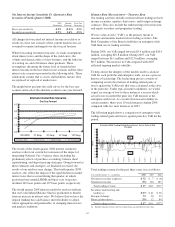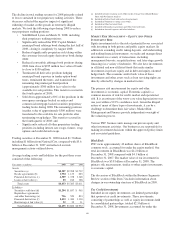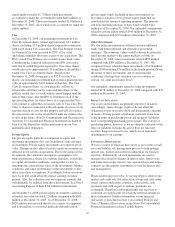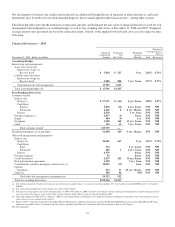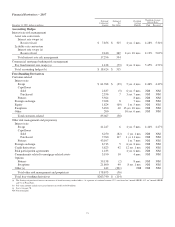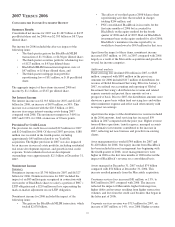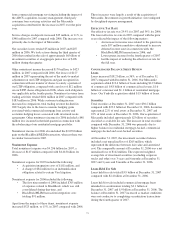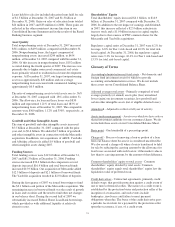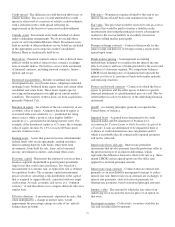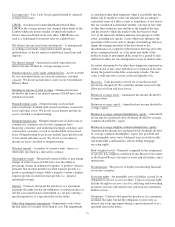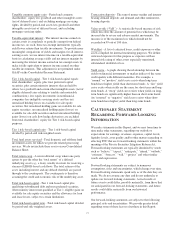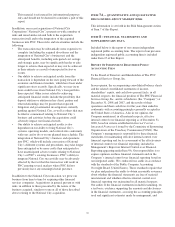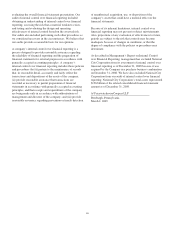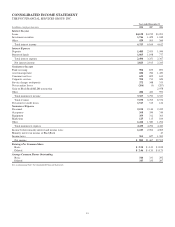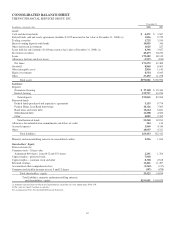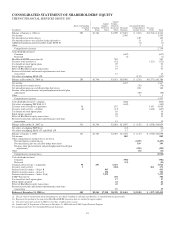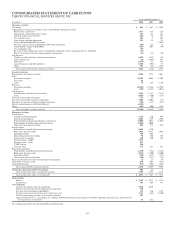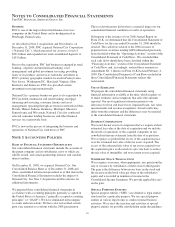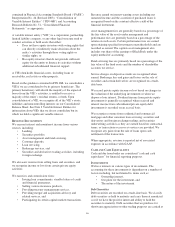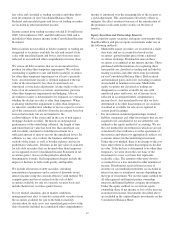PNC Bank 2008 Annual Report Download - page 81
Download and view the complete annual report
Please find page 81 of the 2008 PNC Bank annual report below. You can navigate through the pages in the report by either clicking on the pages listed below, or by using the keyword search tool below to find specific information within the annual report.
Tangible common equity ratio - Period-end common
shareholders’ equity less goodwill and other intangible assets
(net of deferred taxes), and excluding mortgage servicing
rights, divided by period-end assets less goodwill and other
intangible assets (net of deferred taxes), and excluding
mortgage servicing rights.
Taxable-equivalent interest - The interest income earned on
certain assets is completely or partially exempt from federal
income tax. As such, these tax-exempt instruments typically
yield lower returns than taxable investments. To provide more
meaningful comparisons of yields and margins for all interest-
earning assets, we use interest income on a taxable-equivalent
basis in calculating average yields and net interest margins by
increasing the interest income earned on tax-exempt assets to
make it fully equivalent to interest income earned on other
taxable investments. This adjustment is not permitted under
GAAP on the Consolidated Income Statement.
Tier 1 risk-based capital - Tier 1 risk-based capital equals:
total shareholders’ equity, plus trust preferred capital
securities, plus certain minority interests that are held by
others; less goodwill and certain other intangible assets (net of
eligible deferred taxes relating to taxable and nontaxable
combinations), less equity investments in nonfinancial
companies less ineligible servicing assets and less net
unrealized holding losses on available for sale equity
securities. Net unrealized holding gains on available for sale
equity securities, net unrealized holding gains (losses) on
available for sale debt securities and net unrealized holding
gains (losses) on cash flow hedge derivatives are excluded
from total shareholders’ equity for Tier 1 risk-based capital
purposes.
Tier 1 risk-based capital ratio - Tier 1 risk-based capital
divided by period-end risk-weighted assets.
Total fund assets serviced - Total domestic and offshore fund
investment assets for which we provide related processing
services. We do not include these assets on our Consolidated
Balance Sheet.
Total return swap - A non-traditional swap where one party
agrees to pay the other the “total return” of a defined
underlying asset (e.g., a loan), usually in return for receiving a
stream of LIBOR-based cash flows. The total returns of the
asset, including interest and any default shortfall, are passed
through to the counterparty. The counterparty is therefore
assuming the credit and economic risk of the underlying asset.
Total risk-based capital - Tier 1 risk-based capital plus
qualifying subordinated debt and trust preferred securities,
other minority interest not qualified as Tier 1, eligible gains on
available for sale equity securities and the allowance for loan
and lease losses, subject to certain limitations.
Total risk-based capital ratio - Total risk-based capital divided
by period-end risk-weighted assets.
Transaction deposits - The sum of money market and interest-
bearing demand deposits and demand and other noninterest-
bearing deposits.
Value-at-risk (“VaR”) - A statistically-based measure of risk
which describes the amount of potential loss which may be
incurred due to severe and adverse market movements. The
measure is of the maximum loss which should not be
exceeded on 99 out of 100 days.
Watchlist - A list of criticized loans, credit exposure or other
assets compiled for internal monitoring purposes. We define
criticized exposure for this purpose as exposure with an
internal risk rating of other assets especially mentioned,
substandard, doubtful or loss.
Yield curve - A graph showing the relationship between the
yields on financial instruments or market indices of the same
credit quality with different maturities. For example, a
“normal” or “positive” yield curve exists when long-term
bonds have higher yields than short-term bonds. A “flat” yield
curve exists when yields are the same for short-term and long-
term bonds. A “steep” yield curve exists when yields on long-
term bonds are significantly higher than on short-term bonds.
An “inverted” or “negative” yield curve exists when short-
term bonds have higher yields than long-term bonds.
C
AUTIONARY
S
TATEMENT
R
EGARDING
F
ORWARD
-L
OOKING
I
NFORMATION
We make statements in this Report, and we may from time to
time make other statements, regarding our outlook or
expectations for earnings, revenues, expenses, capital levels,
liquidity levels, asset quality and/or other matters regarding or
affecting PNC that are forward-looking statements within the
meaning of the Private Securities Litigation Reform Act.
Forward-looking statements are typically identified by words
such as “believe,” “expect,” “anticipate,” “intend,” “outlook,”
“estimate,” “forecast,” “will,” “ project” and other similar
words and expressions.
Forward-looking statements are subject to numerous
assumptions, risks and uncertainties, which change over time.
Forward-looking statements speak only as of the date they are
made. We do not assume any duty and do not undertake to
update our forward-looking statements. Actual results or
future events could differ, possibly materially, from those that
we anticipated in our forward-looking statements, and future
results could differ materially from our historical
performance.
Our forward-looking statements are subject to the following
principal risks and uncertainties. We provide greater detail
regarding some of these factors elsewhere in this Report,
77


